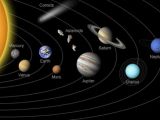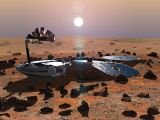Not to ruin anyone’s good mood or anything of the sorts, but it must be said that one more week has gone by. That’s right, we are now a wee older than we were the last time we celebrated the end of an otherwise perfect Sunday together.
As per usual, there was a whole lot of commotion in the world of science these past few days. Just in case some of you were too busy to keep tabs on the news, here’s a round-up of the absolute best science announcements of the week.
10. Dolphin-like ancient reptile found in Scotland
Based on an analysis of fossilized bones unearthed several decades back by an amateur paleontologist, scientists documented a previously unknown species of ancient reptile that populated Scotland’s waters about 170 million years ago.
The reptile, dubbed Dearcmhara shawcrossi, looked very much like a dolphin, except that it had a rather long and narrow snout. It is estimated that it could grow to measure 14 feet (4.2 meters) in length. Before anyone asks, no, it did not use to dress in kilts made of seaweed.
What’s interesting is that this ancient reptile appears to be native to Scotland. Thus, Dearcmhara shawcrossi fossils have so far only been discovered on the Isle of Skye, in the Bearreraig Bay. Otherwise put, the species is most likely uniquely Scottish.
9. New planets might be lurking at the edge of the Solar System
This week, scientists announced that, having taken the time to study the behavior of celestial bodies known as extreme trans-Neptunian objects, they found evidence that at least two undocumented dwarf planets might be lurking at the edge of the Solar System, well beyond Pluto.
As explained by the researchers behind this investigation, extreme trans-Neptunian objects are celestial bodies that are distributed randomly beyond Neptune and that should all display a predictable orbital behavior. The thing is that some of them tend to behave rather hectically.
All things considered, it could be that the peculiar orbital behavior displayed by some extreme trans-Neptunian objects is due to the influence of gravitational forces not yet discovered by science. It is these gravitational forces that astronomers believe could be generated by unknown planets.
8. Anxiety in combat veterans linked to brain damage
A new paper makes a case of how, according to evidence at hand, it is possible that brain damage need be blamed for at least some of the cases of anxiety, post-traumatic stress, depression and substance abuse documented among combat veterans.
More precisely, researchers say that, while autopsying the brain of several combat veterans, they found damaged and swollen nerve fibers arranged in a honeycomb pattern. Interestingly enough, such patterns in the brain have never before been documented in relation to various injuries.
Hence, it might be that the combat veterans autopsied as part of this investigation owed their damaged and swollen nerve fibers to blasts they experienced while taking part in one battle or another. If this were true, the honeycomb patterns could be the signature of shell shock.
7. Massive solar flare documented in new NASA image
On January 12, our Sun let out a freakishly strong burst of radiation. The event, known to the scientific community as a solar flare, was documented by astronomers with the help of NASA’s Solar Dynamics Observatory. Soon enough, an image of the solar flare hit the public eye.
As explained by scientists, this burst of radiation that occurred on the surface of the Sun this past January 12 was the strongest recorded since the beginning of the year until now. Specifically, the burst was catalogued as an M5.6-class solar flare.
The good news is that, as strong as a solar flare might be, the radiation produced by it cannot make it all the way through our planet’s atmosphere and, well, fry us. It can, however, upset the atmosphere’s upper layer and, in doing so, mess with GPS and communication signals.
6. Oxygen argued to give people lung cancer
In what might be the absolute freakiest news of the week, a team of researchers announced that, according to their investigations into the matter at hand, it might be that the oxygen in the very air we breathe can cause us to develop lung cancer at one point in our life.
Thus, it appears that lung cancer rates are much lower among people who live at higher elevations and who are, therefore, exposed to air whose oxygen content is somewhat reduced. What’s interesting is that, as it turns out, other forms of cancer are just as common at higher elevations as they are at lower ones.
Specialists say that it really isn’t all that far-fetched to argue that oxygen can give people lung cancer. This is because, when metabolized, oxygen produces chemically reactive molecules known as reactive oxygen species. As shown by other investigations, these molecules can trigger mutations and damage.
5. Spacecraft lost on Mars in 2003 finally found
This week, scientists went public with the news that, having the time to closely analyze images provided by NASA’s Mars Reconnaissance Orbiter, they found the final resting place of the Beagle 2 spacecraft that left Earth in June 2003 and reached the Red Planet just a few months later.
Based on these images, researchers concluded that Beagle 2 did not simply crash into Mars when it finally reached it on December 25, 2003. On the contrary, it managed to make a smooth landing on its surface. Presently, it is still unclear why the spacecraft lost contact with Earth when reaching its target.
The images that led to the discovery of Beagle 2 show an impact crater that goes by the name of Isidis Planitia and that is located not far from the Red Planet’s equator. In case anyone was wondering, Beagle 2 did not end up in this crater by mistake. On the contrary, it was supposed to land in it to begin with.
4. Ancient viruses argued to make us smarter
This might come as a bit of a surprise, but as it turns out, we all carry the genomic residue of ancient viral infections in our body. Otherwise put, our genetic makeup includes bits and pieces of DNA originating from viruses that are millions of years old.
For a very long while, it was believed that these so-called endogenous viruses that make up as much as 4.9% of the human genome did nothing whatsoever. Specifically, they were believed to be junk DNA. Leave it to a new study to prove these claims wrong.
Long story short, it appears that the endogenous viruses we carry is our body help makes us smarter. According to evidence at hand, the viruses contribute to the development of the human brain by being actively involved in the expression of certain genes and the execution of basic brain functions.
3. Portable device used to replace man’s heart
Millions of people are struggling with all sorts of heart conditions in this day and age. The good news is that, thanks to advances made in the field of technology and medicine, some can still enjoy a somewhat normal life even though their heart is barely hanging on.
In fact, technology and medicine made it possible for one man in the US to spend the holiday season with his family even though he no longer has a beating heart. Instead, the man relies on a portable device to pump blood to his tissues and organs, and keep him alive.
The man first started experiencing heart trouble in 2007, when he simply collapsed without warning during a basketball game. In time, his condition got worse, and last year, doctors replaced his heart with the portable device, which the man will use until the transplant surgery that hopefully saves his life.
2. Asteroid visit announced for January 26
About a week from now, on January 26, an asteroid is expected to buzz by our planet. The space rock, estimated to measure about 0.5 miles (0.3 kilometers) across at its widest point, will come within 1.2 million kilometers (about 745,000 miles) of Earth.
To put things into perspective, it must be said that this distance is three times greater than the one between our planet and its moon. Hence, astronomers say that there is no reason to worry that the asteroid might crash into Earth and wipe out humanity as we know it.
The space rock that will visit us this coming January 26 goes by the name of 2004 BL86. The celestial body was discovered back on January 30, 2004, with the help of a telescope of the Lincoln Near-Earth Asteroid Research survey in White Sands, New Mexico.
1. 2014 confirmed as the hottest year ever recorded
This week, both NASA and NOAA issued reports saying that 2014 was the absolute hottest year ever documented since record keeping began back in 1880. The scientists who authored these reports agree that global warming is to blame for the record temperatures from last year.
In its report, NOAA says that the average global surface temperature documented in 2014 was one of 14.58 degrees Celsius (58.24 degrees Fahrenheit). This temperature marks an increase of 0.69 degrees Celsius (1.24 degrees Fahrenheit) when compared to the 20th century average.
NASA, on the other hand, argues that the average global surface temperature in 2014 was one of 14.68 degrees Celsius (58.42 degrees Fahrenheit), and goes on to detail that this figure represents a 0.68 degrees Celsius (1.22 degrees Fahrenheit) increase over the period 1951-1980.
Both NOAA and NASA researchers agree that, under a business-as-usual-scenario, the world stands to get even hotter in the years to come. Thus, the scientists say that the only way to curb global warming is to cut greenhouse gas emissions and do so sooner rather than later.
This rather worrying news concludes this week’s round-up. If you’re one of those people who like to keep up to date with what researchers are up to these days, be sure to check this page again next Sunday.

 14 DAY TRIAL //
14 DAY TRIAL // 









